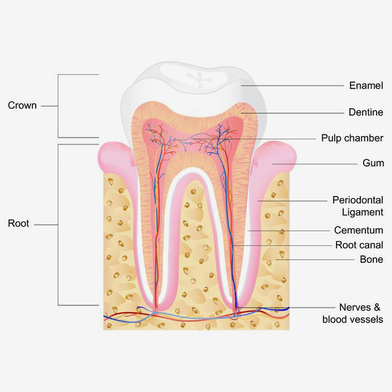Root Canals

The diagram at right illustrates the inside of a healthy tooth. A tooth is a living structure; inside, it contains pulp, blood vessels, nerves, and connective tissue. A healthy tooth may last an entire lifetime; however, it can become damaged by injury, decay, or disease.
When damaged, a tooth can become abscessed, that is, inflamed and infected. The living tissue inside the tooth will likely die. The infection can spread to the bone that anchors the tooth. An abscessed tooth should not be left untreated because the infection can lead to the loss of the tooth and impact your immune system.
Healing an abscess may require antibiotics and an endodontic treatment, more often known as a root canal, to restore the tooth's function. The root canal treatment involves removing and replacing a tooth's pulp tissue. Under a local anesthetic, the dentist creates an opening in the crown of the tooth, removes the diseased pulp, cleans and shapes the inside of the root canal, and then fills and seals the space.
Depending on the damage and condition of the tooth, a crown may be required to restore the original function of the tooth.
Symptoms
If you are experiencing symptoms of tooth pain, sensitivity to heat or cold, swollen neck glands, fever, swelling, even a bitter taste or foul smell in your breath, contact us immediately to have your problem diagnosed.
Resources
Dental Health and the Abscessed Tooth (Courtesy WebMD)
Slide Show: Root Canal Treatment (Courtesy Mayo Clinic)





